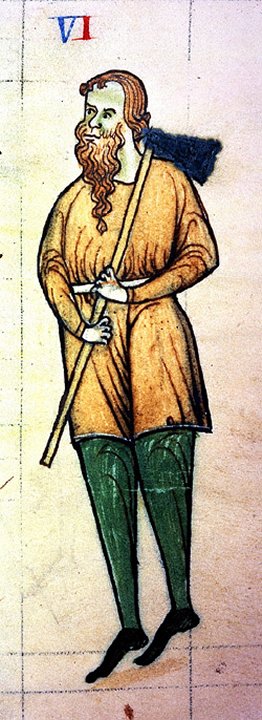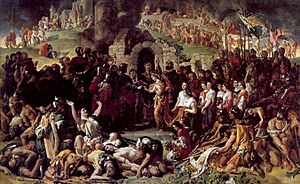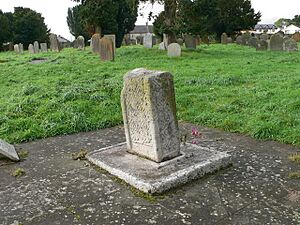Diarmait Mac Murchada facts for kids
Quick facts for kids Diarmait Mac Murchadha |
|
|---|---|
| King of Leinster | |

Diarmait as depicted in the Expugnatio Hibernica, c. 1189
|
|
| King of Leinster in Ireland | |
| Reign | 1126–1171 |
| Predecessor | Enna mac Donnchada Mac Murchada |
| Successor | Domhnall Caomhánach mac Murchada |
| Born | c. 1110 Leinster, Ireland |
| Died | c. 1 May 1171 |
| Burial | Ferns, County Wexford |
| Spouse |
|
| Issue |
|
| House | Uí Chennselaig |
| Father | Donnchadh mac Murchada |
| Mother | Orlaith ingen O'Braenain |
Diarmait Mac Murchada (also known as Dermot MacMurrough) was a powerful Irish king. He ruled the kingdom of Leinster in Ireland from 1127 to 1171. He is a very important figure in Irish history because he played a key role in the arrival of the Normans in Ireland.
In 1167, Diarmait was removed from his throne by the High King of Ireland, Ruaidrí Ua Conchobair. To get his kingdom back, Diarmait asked for help from King Henry II of England. He also got military support from a powerful Norman lord named Richard de Clare, 2nd Earl of Pembroke, also known as "Strongbow." This event started the Anglo-Norman invasion of Ireland.
Diarmait promised Strongbow his daughter Aoife in marriage. He also said Strongbow could become the next King of Leinster after him. King Henry II then led a larger invasion in 1171 to make sure he had control over Strongbow. This led to the Normans establishing the Lordship of Ireland. Diarmait became known as Diarmait na nGall, which means "Diarmait of the Foreigners," because he brought the first Anglo-Norman settlers to Ireland.
Contents
Who was Diarmait Mac Murchada?
Diarmait's Early Life and Family
Diarmait was born around 1110. His father, Donnchadh mac Murchada, was also the King of Leinster and Dublin. Diarmait had two wives, which was allowed under the old Irish laws called Brehon laws. His first wife, Sadhbh Ní Faeláin, was the mother of his daughter Órlaith. Órlaith later married Domnall Mór Ua Briain, the King of Munster.
His second wife, Mór ingen Muirchertaig, was the mother of his famous daughter Aoife and his youngest son, Conchobar. Diarmait also had two other sons, Domhnall Caomhánach and Énna. Diarmait is buried in the churchyard of Ferns village.
Becoming King of Leinster
Diarmait became King of Leinster after his older brother, Énna Mac Murchada, died. The High King of Ireland at the time, Toirdelbach Ua Conchobair, didn't like this. He worried that Diarmait would become too powerful. So, Toirdelbach sent another king, Tigernán Ua Ruairc, to attack Leinster.
Ua Ruairc's army caused a lot of damage, trying to starve the people of Leinster. Diarmait was forced off his throne for a short time. But with the help of the Leinster clans, he got his kingdom back in 1132. For the next twenty years, there was an uneasy peace between Diarmait and the High King.
Diarmait was also involved in a famous story about Ua Ruairc's wife, Derbforgaill. Some stories say Diarmait took her away, along with her belongings. Other sources suggest she might have gone with him willingly or sought his protection. Whatever happened, this event added to the bad feelings between the two kings.
Diarmait's Support for the Church
Building Churches and Monasteries
As King of Leinster, Diarmait was a big supporter of the church. Between 1140 and 1170, he ordered the building of several important Irish Romanesque churches and monasteries. These included:
- Baltinglass Abbey
- St Saviour's Priory
- Ferns Abbey
- Killeshin Church
He also helped establish convents (nunneries) in Dublin (St Mary's, 1146), and around 1151, two more in Aghade, County Carlow and Kilculliheen near Waterford city.
Supporting Church Leaders
Diarmait also supported the career of a very important church leader, St Lawrence O'Toole. Diarmait married O'Toole's half-sister, Mor, in 1153. He was also present at a church meeting in Clane in 1161 when O'Toole became the archbishop of Dublin.
Diarmait's Exile and Return to Power
Seeking Help from England
In 1166, Diarmait's main ally, Muirchertach Ua Lochlainn, died. This left Diarmait vulnerable. A large group of forces led by Tigernán Ua Ruairc, Diarmait's old enemy, marched into Leinster. The new High King, Ruaidrí Ua Conchobair, removed Diarmait from his throne.
Diarmait fled to Wales, then to England and France. He was looking for help from King Henry II of England to get his kingdom back. Henry II gave Diarmait permission to find soldiers and mercenaries (paid soldiers) in his kingdom.
The Arrival of the Normans
Several powerful Norman lords agreed to help Diarmait. These included Richard de Clare (Strongbow) and his half-brothers Robert FitzStephen and Maurice FitzGerald. Diarmait promised Strongbow his daughter Aoife in marriage and the right to become King of Leinster after Diarmait died. Robert and Maurice were promised lands in Wexford for their help.
When Diarmait returned to Wales, Robert FitzStephen helped him gather an army of English and Welsh soldiers. They landed in Ireland at Bannow Bay and attacked Wexford, which fell in May 1169. They then raided other areas, including the Kingdom of Ossory.
Regaining Leinster
King Ruaidrí Ua Conchobair could no longer ignore this strong force. He marched his army into Leinster. With the help of the Church, the two sides began talks at Ferns, Diarmait's base. They reached an agreement: Diarmait could remain King of Leinster, and he would recognize Ruaidrí as the High King.
Some historians believe there was a secret part of the agreement. Diarmait was supposed to send away the foreign soldiers once Leinster was under control. However, more Norman forces arrived in May 1170, led by Maurice FitzGerald. Diarmait and FitzGerald then marched on the city of Dublin, which surrendered. Soon, all of Leinster was back under Diarmait's control.
Feeling confident, Diarmait sent Robert FitzStephen to help his son-in-law, Domnall Mór Ua Briain, the King of Thomond. Diarmait's goal might have just been to get his throne back. But as the Norman soldiers proved how strong they were, he might have started thinking about becoming the High King himself.
Strongbow arrived in Ireland in 1170 at Waterford. After Waterford fell, Aoife and Strongbow were married. This made Richard FitzGilbert, Strongbow, the lord of Leinster. This marriage was later painted in a famous artwork by Daniel Maclise.

Diarmait was very sad after his youngest son, Conchobar, died. He went back to Ferns and passed away a few months later.
Diarmait's Place in History
In Irish history books written after the 1800s, Diarmait Mac Murchada was often seen as a "traitor." However, his main goal was not to help an English invasion of Ireland. He wanted to use Henry II's help to become the High King of Ireland himself. The Normans who came to Ireland were looking for land and wealth. King Henry II didn't originally plan to invade Ireland; he reacted to Strongbow gaining too much power.
A writer named Gerald of Wales, whose family members were Norman soldiers, described Diarmait like this:
Dermot was a tall and strong man. He loved battle and was brave among his people. He was a man who preferred to be feared by everyone rather than loved by anyone. He was harsh to his own people and disliked by strangers.
Diarmait's Death and Family Line
The Norman Control of Ireland
After Strongbow's successful invasion, Henry II led a second, larger invasion in 1171. He wanted to make sure he had control over his Norman lords. He accepted the loyalty of the Irish kings in Dublin in November 1171. He also made sure his claim to Ireland was confirmed by the Pope. He added "Lord of Ireland" to his many titles.
The Normans directly controlled a small area around Dublin and Waterford. The rest of Ireland was divided between English lords and Irish clans. The 1175 Treaty of Windsor, helped by St Lawrence O'Toole, made official the loyalty of the Irish clans who still ruled their lands.
Diarmait's Descendants
Diarmait's family line continued through his descendants. These included Art Óg mac Murchadha Caomhánach (died 1417), who brought back the kingship of Leinster. Another descendant, Cahir mac Art Kavanagh (died 1554), continued to rule parts of Leinster independently. The last proclaimed King of Leinster from this line, Domhnall Spáinneach Mac Murchadha Caomhánach, died in 1632.
Diarmait died around May 1, 1171. He was buried in Ferns Cathedral, where his grave can still be seen today.
Diarmait in Plays
In the play The Dreaming of the Bones by W. B. Yeats, the ghosts of Diarmait and Derbforgaill help an Irish rebel. They say they are bound until an Irishman can forgive them for bringing the Normans to Ireland.
See also
- Irish nobility
- Irish royal families
- Kings of Leinster
- McMorrow
Sources
- Annals of the Four Masters, ed. J. O'Donovan; 1990 edition.
- Expugnatio Hibernica, by Giraldus Cambrensis; ed., with transln and historical notes, by A. B. Scott and F. X. Martin. Dublin: Royal Irish Academy, 1978
- Byrne, Francis J. (1973) Irish Kings and High Kings. London: Batsford (Rev. ed. Dublin: Four Courts, 1999)
- Roche, Richard (1995) The Norman Invasion of Ireland. Dublin: Anvil Books (1st ed. [Tralee]: Anvil Books, c1970)
- O'Byrne, Emmett (2003) War, Politics and the Irish of Leinster 1156-160. Dublin: Four Courts
- Furlong, Nicholas (1973) Dermot, King of Leinster, and the foreigners. Tralee: Anvil Books ISBN: 0-900068-37-X
- --do.-- Dermait, King of Leinster. Cork: Mercier Press, 2006 ISBN: 1-85635-505-5
- Ancestral Roots of Certain American Colonists Who Came to America Before 1700; by Frederick Lewis Weis, Lines: 66–26, 175–6
Sources for genealogy
- Byrne, Francis J. (1973) Irish Kings and High-Kings. London: Batsford (Rev. ed. Dublin: Four Courts, 1999) "Uí Cheinnselaig Kings of Laigin", p. 290
- O'Byrne, Emmett (2003) War, Politics and the Irish of Leinster Dublin: Four Courts; "The MacMurrough-Kavanagh kings of Leinster; Outline Genealogies I, Ia, Ib", pages 247–249.
- O'Hart, John (1892) Irish Pedigrees; 5th ed. 2 vols. Dublin: James Duffy, pp. 157, 555. (1st ed.: 1878; several later eds.)
| Preceded by Énna Mac Murchada |
King of Leinster 1126–1171 |
Succeeded by Domhnall Caomhánach mac Murchada |


